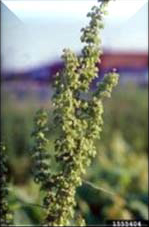 Also Known As
Also Known As
curled dock, curlyleaf dock, narrow dock, narrowleaf dock, sour dock, yellow dock, sorrel
Description
Curly dock, Rumex crispus L., is a robust perennial with a deep, fleshy taproot that is native to Europe and parts of Africa and Asia. The plant initially forms a basal rosette of lance-shaped leaves; it later bolts, sending up an erect flower stalk that can reach 5 feet in height. The flower stalk(s) may arise singly or in small groups from the root crown and are typically unbranched below the flower head; they are hairless, sometimes ridged, stout and hav e swollen joints (nodes). The leaves of curly dock are mostly basal; they are long and linear, hairless, petioled, alternately arranged, and have a prominent midvein and distinctly wavy or “crisped” margins. At each node at the leaf base is a characteristic membranous sheath (ocrea) that encircles the stem. Stem leaves become progressively smaller up the stem. The flowers of curly dock occur in panicles or clusters on the upper stems; the flowers are non-showy, without petals (apetalous), and consist of green sepals that, like the rest of the plant, turn reddish-brown at maturity and remain conspicuous through winter. Each flower matures into a dry fruit—a papery, 3-winged membranous structure with veins that encloses a single reddish-brown, triangular seed. The membranous wings of the fruit are readily dispersed by wind and water. Under good growing conditions, a single plant can produce up to 60,000 seeds, some of which germinate readily, while a large percentage remain viable in the soil for 3 years—and some much longer. While curly dock primarily reproduces and spreads by seed, it can also resprout from root fragments. While some plants flower and die in a single season, others live 3–5years.
Curly dock differs from Broadleaf Dock (Rumex obtusifolius), which has wider, broader leaves and normally has heart-shaped leaf bases. Also, the winged structure enclosing the fruit is irregularly toothed. Photos below for comparison.
Curly dock is found throughout the U.S. and across the rest of the World (all continents). It primarily occurs as a weed of pastures, agronomic crop fields (particularly perennial crops like alfalfa), ditches, roadsides, and waste areas. Curly dock favors wet soil and is often found in poorly-drained or low-lying areas of standing water or where overwatering has occurred.
While curly dock is a valuable food source for the caterpillars of many butterflies, its seeds and foliage can be toxic to animals. The plant is also an alternate host for a number of viruses, fungi, and nematodes. Its greatest impact, however, is its interference with native habitats and competitiveness with crops and native plants for nutrients, sunlight, and space.
Control Methods
Cultural Control: All exotic docks are difficult to control because of high seed production, long-lived seed banks and the ability to regenerate from root segments. They do not, however, tolerate crowding by more vigorous species or tillage. Infestations in perennial crops can be reduced by shifting to annual crops that need or tolerate a tilled cropping system.
Mechanical/Physical Control: For small populations of young plants, a spade or shovel can be used to dig out the plant—removing as much of the root system as possible. For more mature populations, plants can be eradicated by continually removing above-ground growth in order to exhaust the energy supply stored in the plants’ roots. Mowing before seed set will prevent seed production but will not control dock unless it is routinely repeated or is combined with another control option, i.e., chemical control. While curly dock does not tolerate regular tillage, tillage practices can result in root fragmentation and regeneration.
Chemical Control: Several chemicals (or combinations thereof) are available for control of curly dock: metsulfuron, chlorsulfuron, glyphosate, clopyralid, aminopyralid, triclopyr and 2,4-D. Post-emergent herbicides should be applied to actively growing plants in the spring and early summer; however, once curly dock becomes established, fall applications work best. Curly dock in alfalfa is difficult to control and must be treated when it is a seedling with different pesticides than those listed above (except glyphosate).
More information can be found in the PNW Weed Management Handbook
- Use pesticides with care.
- Apply them only to plants, animals, or sites listed on the label.
- When mixing and applying pesticides, follow all label precautions to protect yourself and others around you.
- It is a violation of the law to disregard label directions.
- Store pesticides in their original containers and keep them out of the reach of children, pets, and livestock.
Biological Control: Biological control agents are not available and would have to be highly host specific since dock is closely related to desirable crops, e.g., rhubarb and buckwheat. Livestock do not readily eat the plant, so grazing simply reduces competition and enables curly dock to establish or spread.












